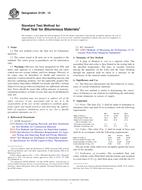Potrebujeme váš súhlas na využitie jednotlivých dát, aby sa vám okrem iného mohli ukazovať informácie týkajúce sa vašich záujmov. Súhlas udelíte kliknutím na tlačidlo „OK“.
ASTM D6648-08
Standard Test Method for Determining the Flexural Creep Stiffness of Asphalt Binder Using the Bending Beam Rheometer (BBR)
Automaticky preložený názov:
Štandardná skúšobná metóda pre stanovenie flexurální Creep tuhosť asfaltového spojiva Použitie Ohýbanie Beam Rheometer (BBR)
NORMA vydaná dňa 15.1.2008
Informácie o norme:
Označenie normy: ASTM D6648-08
Poznámka: NEPLATNÁ
Dátum vydania normy: 15.1.2008
Kód tovaru: NS-36015
Počet strán: 15
Približná hmotnosť: 45 g (0.10 libier)
Krajina: Americká technická norma
Kategória: Technické normy ASTM
Kategórie - podobné normy:
Anotácia textu normy ASTM D6648-08 :
Keywords:
bending beam rheometer, flexural creep compliance, flexural creep stiffness, Asphalt binder, BBR (bending beam rheometer), Flexural testing--concrete, Rheometers, ICS Number Code 19.060 (Mechanical testing), 93.080.20 (Road construction materials)
Doplňujúce informácie
| Significance and Use | ||||||||||||||
|
The temperatures for this test are based upon the winter temperature experienced by the pavement in the geographical area for which the asphalt binder is intended. The flexural creep stiffness or flexural creep compliance, determined from this test, describes the low-temperature stress-strain-time response of asphalt binder at the test temperature within the range of linear viscoelastic response. The low-temperature thermal cracking performance of asphalt pavements is related to the creep stiffness and the m-value of the asphalt binder contained in the mix. The creep stiffness and the m-value are used as performance-based specification criteria for asphalt binders in accordance with Specification D 6373. |
||||||||||||||
| 1. Scope | ||||||||||||||
|
1.1 This test method covers the determination of the flexural-creep stiffness or compliance and m-value of asphalt binders by means of a bending beam rheometer. It is applicable to material having flexural-creep stiffness values in the range of 20 MPa to 1 GPa (creep compliance values in the range of 50 nPa–1 to 1 nPa–1) and can be used with unaged material or with materials aged using aging procedures such as Test Method D 2872 or Practice D 6521. The test apparatus may be operated within the temperature range from –36°C to 0°C. 1.2 Test results are not valid for test specimens that deflect more than 4 mm or less than 0.08 mm when tested in accordance with this test method. 1.3 This standard does not purport to address all of the safety concerns, if any, associated with its use. It is the responsibility of the user of this standard to establish appropriate safety and health practices and determine the applicability of regulatory limitations prior to use. |
||||||||||||||
| 2. Referenced Documents | ||||||||||||||
|
Podobné normy:
Historická
15.9.2007
Historická
1.11.2009
Historická
1.1.2012
Historická
1.6.2012
Historická
1.12.2012
Historická
1.6.2014
Odporúčame:
Aktualizácia technických noriem
Chcete mať istotu, že používate len platné technické normy?
Ponúkame Vám riešenie, ktoré Vám zaistí mesačný prehľad o aktuálnosti noriem, ktoré používate.
Chcete vedieť viac informácií ? Pozrite sa na túto stránku.



 ASTM D1188-07e1
ASTM D1188-07e1 ASTM D1195/D1195M-09..
ASTM D1195/D1195M-09.. ASTM D1196/D1196M-12..
ASTM D1196/D1196M-12.. ASTM D1369-84(2012)..
ASTM D1369-84(2012).. ASTM D139-12
ASTM D139-12 ASTM D140/D140M-14..
ASTM D140/D140M-14..
 Cookies
Cookies
